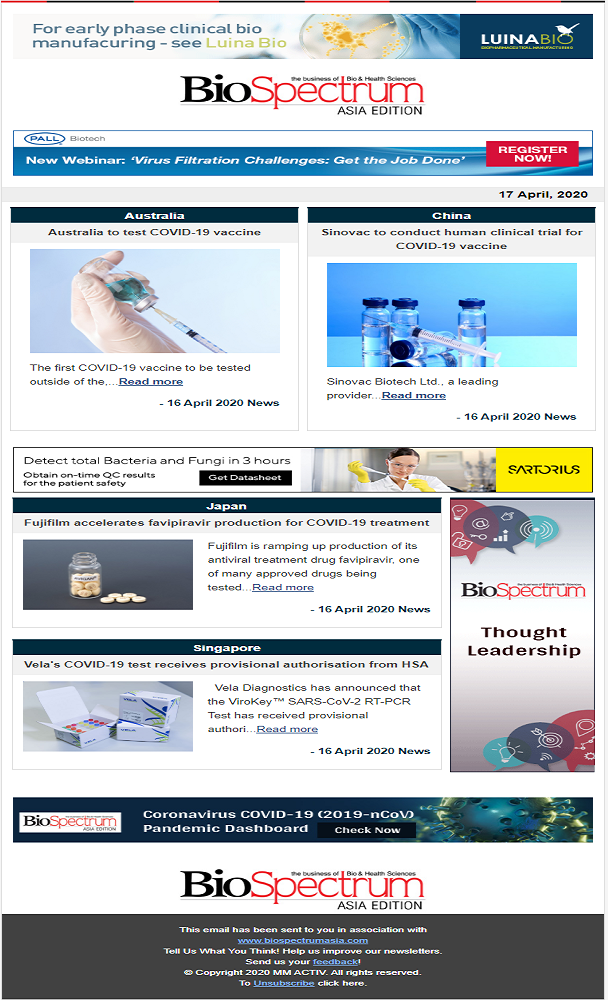
Asia Pacific Medical Technology Association (APACMed) will be hosting the 10th anniversary edition of the Asia Pacific MedTech Forum - how has the forum evolved over the years? What role does it play in the APAC MedTech landscape?
From 511 attendees in 2016 to over 1,600 attendees in 2023, our flagship event, the Asia Pacific MedTech Forum, has not only grown in participation but in the way we choose to innovate every year to support the industry as it constantly evolves.
More than just a conference, the forum is a catalyst for change. We convene the brightest minds in the industry – global corporate leaders, visionary healthcare providers, and influential policymakers – to engage in critical dialogues that will shape the future of MedTech. Breaking the mould, this special 10th edition of the forum offers a dynamic experience unlike any before, promising to foster deeper interaction and collaboration.
Some highlights participants can expect from this year’s forum include:
Register for APACMed’s MedTech Forum 2024 here: https://registration.
What role does APACMed play in advocating for patient access to advanced medical technologies, and how do you work with different stakeholders to achieve this?
Innovation in medical technology has the potential to revolutionise healthcare. From prevention, early detection, to cure, medical technology is life-changing and is a vital part of the whole patient journey. Ensuring everyone has access to these life-changing advancements is crucial.
Across APAC, diverse populations face complex challenges in accessing healthcare. We believe a unified voice can break down these barriers and accelerate widespread adoption.
Our mission is clear- to make innovative medical technologies accessible to more people across the APAC region. We achieve this by collaborating with leading companies, stakeholders, healthcare providers, and governments.
Our Government Affairs and Policy Committee works with policymakers and other stakeholders across the healthcare ecosystem to shape policies and processes that facilitate increased access and affordability of medical technologies for patients in the APAC region. This includes advocating for business-friendly trade and healthcare policies. By proactively anticipating and responding to policy changes throughout the region, our association serves as a vital bridge between policymakers and the MedTech community across APAC.
Our Market Access Committee champions value assessment and funding to enhance patient access by promoting smoother and well-defined post-approval market access pathways, facilitating robust, bi-directional market intelligence and best practice sharing amongst economies across the region, promoting the benefit of patients and healthcare systems by advocating for policies that ease digital health reimbursement and highlighting the substantial value in-vitro diagnostics provide to patients, healthcare professionals, providers/laboratory professionals, policymakers, and payers in the region.
Our Regulatory Affairs Committee provides access to actionable regulatory intelligence for its members, helping them navigate a fragmented and complex regulatory landscape. It also advocates for harmonised regulatory requirements where possible across APAC countries through capacity building and best practice sharing, and promotes regional and global convergence by securing a seat at the table with key harmonisation platforms. It builds thought leadership in prioritised areas, as well as fosters long-term partnerships with regulatory authorities, peer associations, academia, and industry.
Our Health Data Committee works to raise awareness and work towards a common set of standards to optimise the utilisation of health data for innovation and improved patient outcomes. We’re also driving awareness and developing harmonised and robust cybersecurity frameworks against evolving cyber threats so that healthcare data is not compromised in an increasingly connected healthcare ecosystem.
The Legal, Ethics, and Compliance Committee works to raise standards of doing business across the Asia Pacific region, including the facilitation of ethical interactions between industry and HCPs, and industry adherence to APACMed’s Code of Ethical Conduct. By doing so, we elevate the industry’s credibility, allowing us to have a stronger voice in advocacy.
We also continue to promote innovation in the industry through the APACMed Innovation Community (AIC). It serves as a MedTech innovation meeting ground for early- and mid-stage companies seeking support with scaling up, in the APAC region and beyond.
Could you share some success stories or case studies where APACMed's initiatives have significantly impacted the medical technology landscape in the Asia Pacific region?
APACMed has significantly impacted the medtech landscape in APAC through our policy shaping around integrating innovative technology into the health systems of the region, being a bridge between startups and corporations to facilitate innovation, and driving knowledge sharing in the fast-evolving area of ESG.
Policy shaping:
Innovation bridge:
Knowledge sharing on ESG:
What are the primary goals and initiatives APACMed is currently focusing on to drive innovation and collaboration in the medical technology sector across the APAC region?
We are the only regional trade association that brings the medical device industry together. Our focus is on accelerating access to innovation through strong partnerships with governments, enabling us to define new regulatory pathways or reimbursement models for faster access to new technologies.
Policy advocacy remains a critical agenda item, with efforts geared towards improving regulatory processes and market access for innovative technologies. APACMed's engagement with regulatory bodies aims to streamline approvals and explore reimbursement pathways for life-changing MedTech solutions to reach patients and that, swiftly. We are actively promoting this in areas like software-as-a-medical-device (SaMD) and AI, through in-country advocacy as well as cross-country platforms.
We also act as a bridge between startups and corporations to forge partnerships that encourage and nurture new technologies. Over 90% of the estimated 30,000 MedTech companies in the region are SMEs, which face unique challenges in scaling and accessing resources. To address these, APACMed is focusing on enhancing capability development and fostering a supportive ecosystem through initiatives like comprehensive training programs and a robust matchmaking database that connects startups with corporates, investors, and academia.
How is APACMed addressing the challenges related to digital health and the integration of AI in medical technologies, and what are the key opportunities you see in this area?
The integration of AI in medical devices will be a gamechanger for better patient outcomes and a more efficient healthcare system. APACMed is working closely with its members to also shape the regulatory and reimbursement pathways needed for faster patient access.
Data accessibility and the integration of AI into existing workflows are significant challenges. APACMed advocates for policies that improve data accessibility and enhance computational infrastructure. APACMed works closely with our members and governments to promote interoperability and international health data standards across the ASEAN region, through capacity building and best practice sharing. In 2022, we established the Digital Health Reimbursement Alliance, expanding to include a wider range of stakeholders beyond our traditional network of MedTech companies. Under this alliance, we are driving capability building and advocacy regarding the importance of access to digital health technologies by shaping current policies on reimbursement, which is a key lever for the adoption of such technologies.
In our engagements with the region’s governments, we share best practices for cross-learning. For example, South Korea’s National Data Policy facilitates the sharing of anonymized health-related data, which is crucial for training AI models. In Japan, initiatives like the collaboration between the government and private sectors to develop AI-integrated care facilities and robotic surgery systems are gaining momentum. These efforts ensure that MedTech companies have the necessary resources and regulatory support to innovate and compete effectively on a global scale.
Additionally, in the key area of software as a medical device, we have collaborated with governments across the region to create a harmonised framework for both regulatory approvals and reimbursement. This initiative is ongoing and also involves highlighting best practices across the world that are discussed with policymakers in key APAC markets.
APACMed also believes in proactively addressing the challenges related to integrating AI in medical technologies by establishing supportive policies such as building a robust AI talent ecosystem across APAC. One of the primary challenges is the intense competition for skilled talent proficient in both AI and medical domains. APACMed has initiated partnerships with government agencies and educational institutions in several countries to develop a pipeline of 'bilingual' talent. For instance, AI Singapore’s AI Apprenticeship Program (AIAP) focuses on enhancing engineering skills through deep-skilling training and industry projects. Additionally, similar programs are being explored in countries like Australia and South Korea to address the talent gap.
The opportunities in integrating AI in MedTech are transformative. AI is set to revolutionise product differentiation and productivity across the MedTech value chain. APACMed sees substantial potential in AI-driven innovations such as embedded health monitoring sensors, precision medicine, and autonomous robotic surgeries. For instance, autonomous robotic surgeries, which are being developed and deployed in Japan, leverage AI and advanced robotics to perform precise and minimally invasive procedures. Another example is the use of AI-enhanced bio-devices in China, where bioelectronic medicine devices use electrical stimulation to treat chronic diseases. These technologies not only improve patient outcomes but also contribute to proactive, value-based care. By leveraging AI, the MedTech industry can enhance operational efficiency, reduce costs, and create personalised patient experiences, driving the next generation of healthcare solutions in the Asia Pacific region.
Can you elaborate on APACMed's efforts to enhance regulatory harmonisation across the APAC countries, and what impact has this had on the medical technology industry so far?
Regulatory harmonisation is a key focus area for our members. APACMed has been active for several years in pioneering cross-market collaboration to accelerate the approval process. Our work in Southeast Asia, for instance in Singapore, Thailand, Malaysia, and the Philippines, has been particularly impactful. Our initiatives in these markets have led to regulatory recognition agreements and reliance pathways that streamline regulatory approvals.
Other initiatives include Hong Kong recognising approvals from Singapore's HSA, simplifying the regulatory process for accessing innovative technologies. Korea's MFDS is pursuing membership in the Medical Device Single Audit Program (MDSAP), reducing duplicative audits and costs for manufacturers. Singapore's new NextGen Program expedites the registration of equivalent products in Singapore and relying markets, cutting down approval times and costs.
All these initiatives are not only reducing the administrative burden on manufacturers, allowing them to focus more on innovation, but also expedite patient access to innovative medical technologies in APAC.




